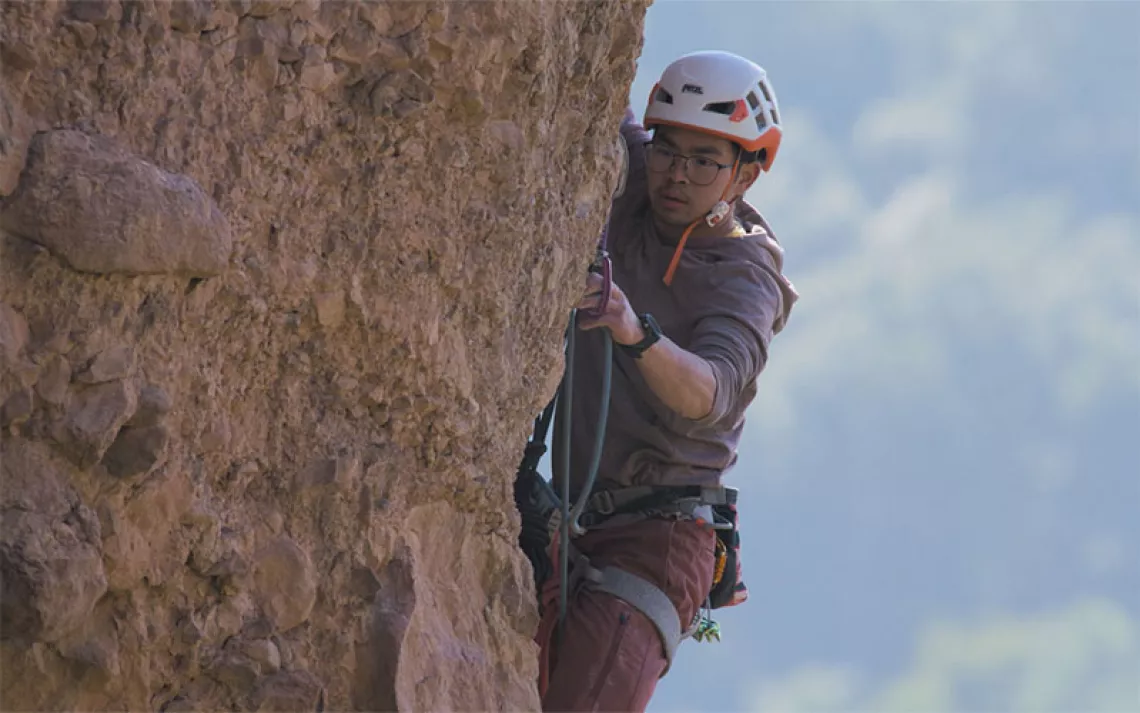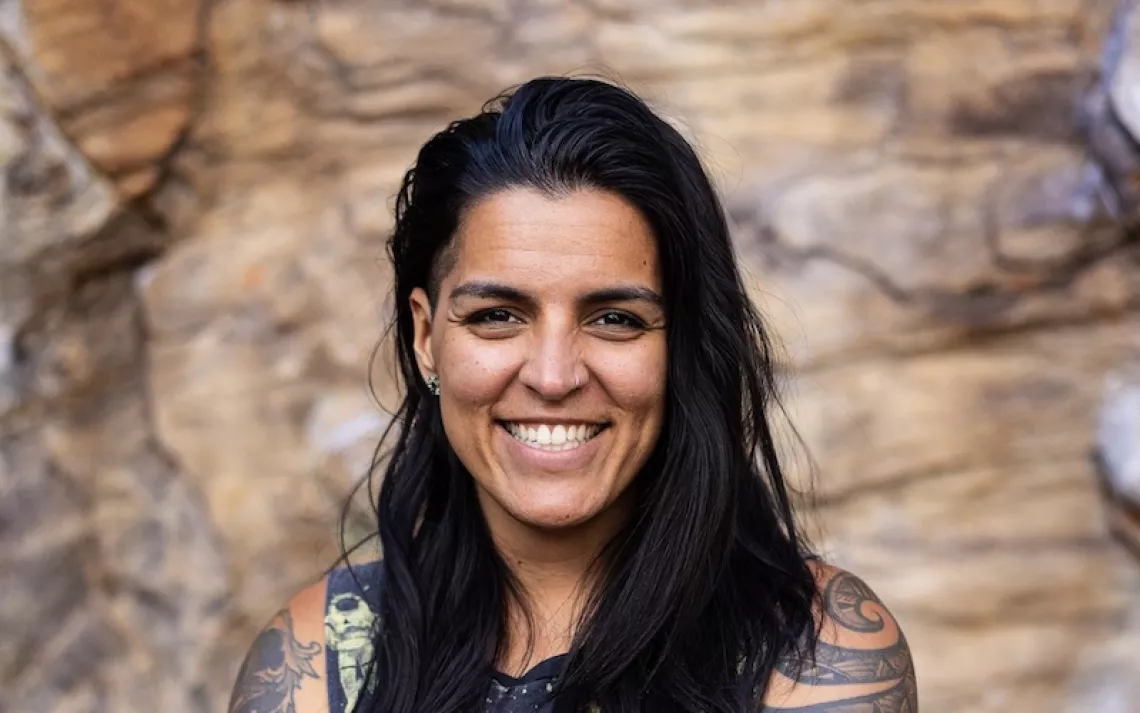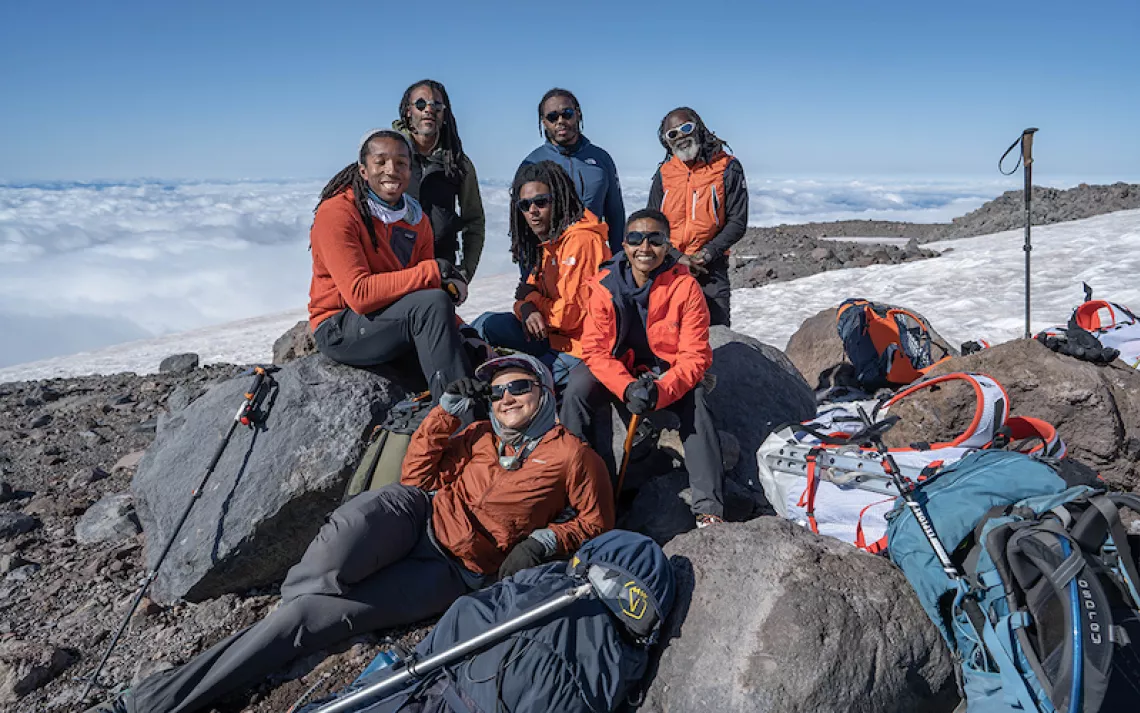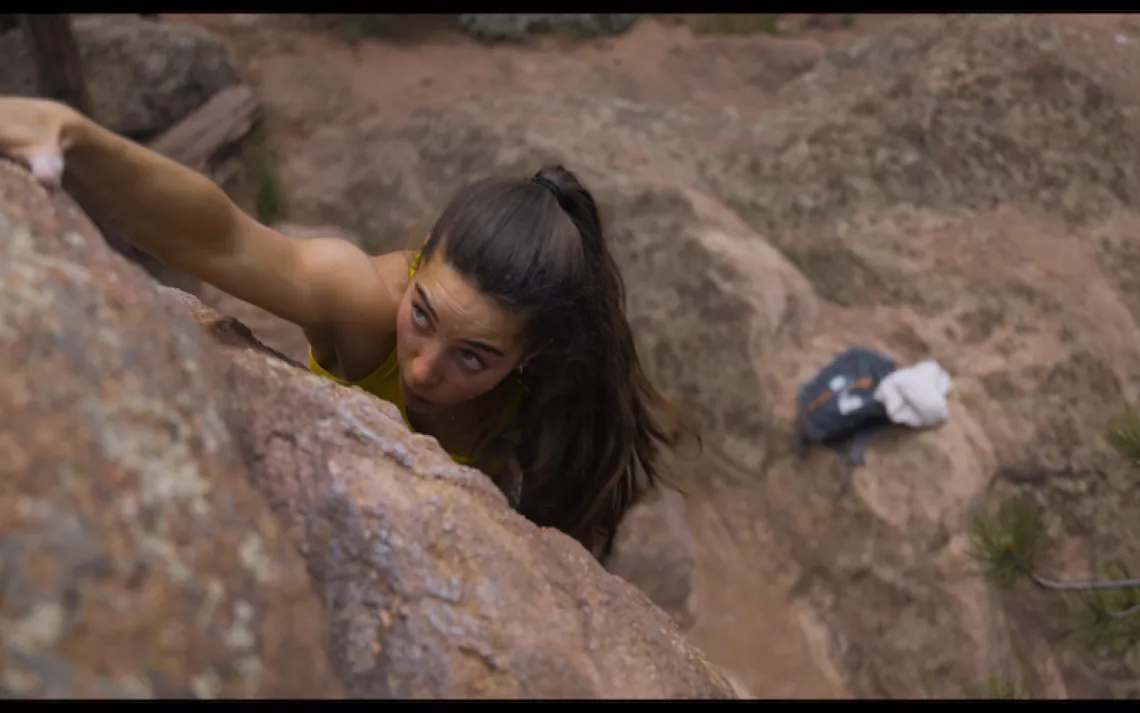Climber Alex Honnold Talks About Freestyling on the Silver Screen
Sierra gets candid with the star, and filmmakers, behind “Free Solo”
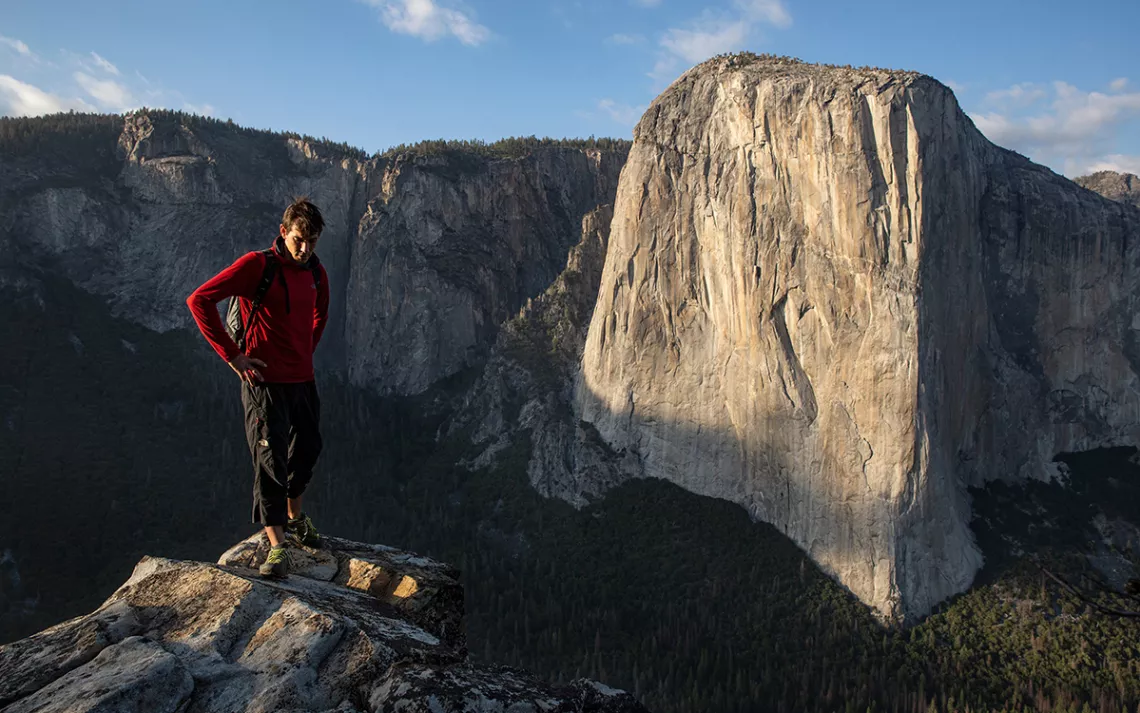
Photos courtesy of National Geographic Documentary Films
At age 31, free climber Alex Honnold became the only person to ever scale El Capitan—the iconic, 3,300-foot rock wall that rises up from California’s Yosemite National Park—without ropes, a harness, or any other protective equipment. More than a flirtation with certain and grisly death, Honnold’s freestyle feat reveals plenty about the psychological forces behind risk, fear, and passion.
Widely considered the world’s greatest surviving free-soloist, Honnold naturally makes for a compelling biopic subject. Luckily, he wasn’t the only one ascending “El Cap,” the rock formation found on Mac screensavers round the world, on that fateful June 2017 day. In tow were a crew of filmmakers who also happened to be pro climbers—but ones who enjoyed the luxury of ropes. Free Solo, the resulting documentary, premiered at last month’s Telluride Film Festival to considerable fanfare—both from the climbing community and from those who’d never in their right mind get vertical and defy death. That’s likely because this film, which follows Honnold’s two-year-long quest to prepare for his feat, isn’t about climbing so much as it is about fear, about overcoming fear, and about those forces within an adventurer that could inspire such high-stakes pursuits.
 Directors Elizabeth Chai Vasarhelyi and Jimmy Chin, the wife-and-husband team known for 2015’s acclaimed mountaineering movie Meru, made use of drones, fixed cameras, and handheld units to depict the world’s most dangerous outdoor adventure, and to needle at the question of what drives their star to a pursuit that does not allow for even a single mistake. Crew members are frequently shown breaking the fourth wall to freak out about the very real possibility that their subject will fall to his death before their eyes and cameras.
Directors Elizabeth Chai Vasarhelyi and Jimmy Chin, the wife-and-husband team known for 2015’s acclaimed mountaineering movie Meru, made use of drones, fixed cameras, and handheld units to depict the world’s most dangerous outdoor adventure, and to needle at the question of what drives their star to a pursuit that does not allow for even a single mistake. Crew members are frequently shown breaking the fourth wall to freak out about the very real possibility that their subject will fall to his death before their eyes and cameras.
With its startling sequences of close and wide shots showing Honnold scampering up various rock faces, Free Solo provides no shortage of tantalizing adventure footage. But the true strength of the film can be credited to its cinema-verité-style portrayal of Honnold’s careful and methodical devotion to his practice, the often adverse effects of his death-defying pursuits on his girlfriend and family, his ascetic lifestyle (he’s lived much of his adult life in a van, gives a third of his income to environmental charities, and keeps a carefully updated climbing journal), and his brain—which viewers get to see getting MRI-scanned. Afterward, a doctor explains that Honnold has a higher-than-normal threshold for stimuli—essentially implying that his superpower is fearlessness.
Alex Honnold is also well known for being a leader in environmental circles—his Honnold Foundation exists to facilitate innovative solar projects in energy-poor regions around the world, and he’s spoken at several Sierra Club events. (Fun fact: the Free Solo crew filmed Honnold delivering the keynote speech at the Club’s 2016 annual fundraiser. Unfortunately, hotel gala footage ultimately couldn’t stack up to Yosemite’s vertigo-inducing vistas, and alas, Honnold’s admonitions to “keep shutting down coal plants” didn’t make the final cut.)
Sierra sat down with the star himself, and with Vasarhelyi and Chin, to learn more about filmmaking, about high-stakes adventurers, and about what they have to show the rest of us about persevering through fear.
Sierra: Tell us about the seed of the idea that became this film.
Elizabeth Chai Vasarhelyi: In 2015, after we finished Meru, our previous film, we were interested in creating a character profile about Alex—there was a lot of material within him, we thought, to tell kind of a deeper story. We weren’t even aware of his El Cap mission at that point.
Alex Honnold: At that point I didn’t even know I was doing it, hadn’t started training for it. I’d been dreaming about it since 2009 or so, but like, on the super lowdown. I’d just tell people, “Oh, I’d love to do it at some point, but we’ll see. . . ." So then when [Vasarhelyi and Chin] approached me about making a film, they presented it as more of a character portrait. But I felt like there wasn’t really a film unless it was about El Cap. Because who wants to make some film about a dude living in a van?
Vasarhelyi: We were willing. It would’ve been a good movie.
Honnold: It met my needs because I’d wanted to freestyle El Cap, but I’d been sorta not quite there, not quite finding the motivation. This brought me on track. "OK," I thought, "we’re working on this project? I’m gonna put in the work to see if it’s possible to freestyle El Cap."
Sierra: Compared with other climbing documentaries, Free Solo seems intended for those who do—and those who don’t—like to defy gravity. Was this inclusivity and accessibility intentional?
Jimmy Chin: Yes, because she [points to Vasarhelyi] isn’t a climber, and she had to make a movie she could watch.
Vasarhelyi: I think we never would’ve approached the story unless we knew it had that potential to connect with all audiences. Take the fact that Alex originally started climbing without a rope, because it was easier than having to speak with someone else, to go out by yourself—that’s always moved both of us. I think everyone has a fear like that in their lives that sets their course. Alex as a kid was awkward, intimidated by vegetables, and scared of intimacy and public speaking. But then he also had this methodical practice that kept developing over the years, and he came up with an audacious dream and achieved it. So the fundamental idea of living life with intention was something Jimmy and I were both interested in, and the story seemed to be big enough to sort of help other people do that. But we generally don’t think about who’s going to watch the movie; we think about authenticity. That said, for Jimmy, it was very important that people who are climbers respect what’s in the film and understand our decisions.
Chin: That was kind of reinforced from what we saw from Meru too. It’s a very niche thing to be into alpine big-wall climbing, but the experience of witnessing that film’s broad reach kind of reconfirmed the idea that a great film is a great film. And who doesn’t want to watch somebody do something extraordinary? Even if it wasn’t El Cap, the type of solo-ing Alex does is incredible. In 20 years in this space, I’ve worked with a lot of incredible athletes, and even for me, it’s so unimaginable that he’s summited El Cap, that he went out and did it. It’s so far out there.
Honnold: To some extent it’s kind of unimaginable for me too. A couple of weeks ago, I was back in Yosemite, sitting there looking at it, and thinking, What a strange period of my life. How did that all come together? Maybe that’s because when I was there, Yosemite was all smoky from recent forest fires—it all has a slight haze and feels even more mystical. You can’t even see the top. It looks insane.
Chin: There’s no climber in the world right now who’s gonna walk up to El Cap and think, "I’m gonna solo that."
Sierra: What about the filming process? How did you manage to capture all those incredible rock face angles—not to mention those shots of Alex’s feet and hands finding the tiniest of cracks?
Chin: The criteria to even be selected to be on the high-angle team was that you had to be a professional climber. And our rigging guys and two main camera guys were too. Which means all our key cameramen were sponsored climbers on the side.
Honnold: He found all of the pro-climber camera people who exist in the world [laughs].
Chin: There’s quite a few people who can rappel and shoot, but it’s another matter altogether to find people who can move efficiently and proficiently on a structure like El Cap, and also who can think 10 steps ahead, which you need to be able to do when you’re filming and moving on a big wall. Our crew was all extraordinarily fit. Our high-angle DP does first ascents all over the world.
Sierra: What surprised you most during the process of making this film?
Vasarhelyi: When we started filming two years ago, Alex was online dating—he was on his book tour [for his 2015 memoir, Alone on the Wall] and setting up dates in some of his stops. I don’t think documentaries are ever funny enough, so I was like, "Oh, we’re gonna have a comedy here," which was good, given the high-stakes nature of the subject matter. But then Sanni [McCandless, Honnold’s girlfriend and a primary Free Solo cast member] came along. She was the most surprising.
Honnold: I hadn’t even met her yet when we started filming. But that’s kind of the nature of a documentary—you just shoot what’s happening. And of course when you first meet and start dating someone, you don’t know how it’s gonna play out. For the first few months it was just like, "Oh, I’m seeing this cool girl. She’s not a climber, so we’ll see how this goes." But two years later, she’s this huge part of my life.
Sierra: Did any other documentaries inspire this film?
Vasarhelyi: Love, Actually [laughs].
Honnold: Mission Impossible [laughs].
Vasarhelyi: Seriously, though, there are so many meaningful documentaries. But Senna [a 2010 British documentary depicting the life and death of Brazilian motor-racing champion Aryton Senna] has always been important.
Chin: Senna’s the first time I realized that a film about a topic I wasn’t interested in—because I didn’t care about formula one racing—could be really captivating. It was about the psychology and stakes of the sport, and the nuances of understanding its real pressures. The question of what it meant to push the edge on something was really captivating, and I always thought that if we could capture that and share with people, it’d be very compelling. We could capture human ambition, the human spirit—the question of what it takes for someone to really take themselves beyond what people thought was possible.
Vasarhelyi: But Senna is made of up archival footage from someone who had died. In Free Solo, that verité rawness—being able to capture real life transpiring in front of the camera—was very important to us.
Honnold: For me, the only relevant film was Meru. I was like, "Oh, they make great films? Cool."
Sierra: What’s the film’s intended takeaway for aspiring free soloists and other climbers?
Honnold: That freestyling can be a beautiful experience—if you lay the proper groundwork, that is—and if you’ve put in the time and effort to properly prepare for it. So I hope the message about preparation really resonates.
Vasarhelyi: For climbers and everyone else in the audience, I think the takeaway should be the fact that Alex lives every day with incredible intention—he’s thought deeply about life and death, and this is the life he chooses to live. And on a very inspiring level, Alex shows that with a lot of practice, you can indeed move through fear.
 The Magazine of The Sierra Club
The Magazine of The Sierra Club
